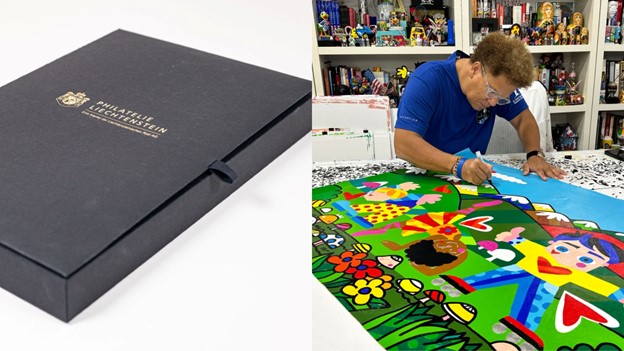In a move that merges tradition with technology, Liechtenstein’s Philatelie has announced the launch of a brand new NFT postage stamp on March 29, 2023.
By acquiring one of the 1,500 available NFTs (part of the so-called NFT-Art-Edition), collectors become virtual co-owners of an accompanying artwork created by Romero Britto, an internationally renowned Neo-Pop-Art artist known for public art installations at Hyde Park and the John F. Kennedy Airport, as well as collaborations with the likes of Disney and Apple. This exclusive painting will be publicly displayed as the first physical-virtual artwork in the Liechtenstein National Museum.
Bridging the worlds of philately, art, and cutting-edge technology, the project offers a unique and unprecedented experience to collectors and enthusiasts.
Tradition meets blockchain
Unlike conventional postage stamps, Post Liechtenstein’s brand new stamp will not only be available to collectors in physical form. Instead, each stamp is accompanied by a unique digital asset that awards collectors digital proof of ownership in the form of an NFT. The NFTs will be available exclusively on the Ethereum blockchain using the ERC-721 standard ensuring permanent transparency and authenticity for their collectors.
The physical stamp combines a century-old steel engraving technique with cutting-edge image processing technologies. Each stamp features a unique image that is part of the custom painting created by “art ambassador” Romero Britto, showcasing the artist’s vibrant and expressive style.
In the words of Roland Seger, CEO at Liechtensteinische Post AG, “with our NFT Art Edition, we have issued a world novelty as a limited edition with a real painting by renowned artist Romero Britto. The NFTs were created through the digital twin of the painting which is now on display in the Liechtenstein National Museum.”
Crucially, each physical stamp also includes a unique tamper-proof SQR code. This code acts as a gateway, granting access to the digital properties associated with the physical stamp. By scanning the SQR code using the dedicated app provided by Post Liechtenstein (dubbed Stamp 4.1), collectors can view the NFT on the Ethereum blockchain along with a wealth of information about their digital collectible.
Finally, the gold foil embossed packaging is further accompanied by a limited-edition art package and a physical authenticity certificate, which provides further security for collectors.
Blockchain: the future of postage stamps?
Liechtenstein’s official Post Service has undoubtedly made waves by introducing an NFT-based postage stamp to celebrate its long-standing partnership with Switzerland. However, the project is hardly blockchain’s first touching point with postage services.
In fact, the Post of Liechtenstein has previously released various other blockchain-based stamps as early as 2021. Among these are the world’s first blockchain-based postage stamp “Stamp 4.0,” which was released in September 2021, as well as special issue stamps to celebrate the late Princess Marie of Liechtenstein.
“Liechtenstein has a well-established blockchain community which has supported us from the start. For our collectors, we were able to connect generations, for example when older collectors gain more NFT knowledge through the help of their younger, more tech-savvy grandchildren,” Seger says.
Since Liechtenstein paved the way for blockchain-powered stamps, other post services around the globe have followed in its footsteps and decided to release their own NFT stamps. For instance, Netherlands’ PostNL and the Austrian Post Office (PostAG) collaborated to release a series of stamps tracked on the blockchain in 2022.
The emergence of cutting-edge technologies like blockchain within traditional institutions such as post services is a truly fascinating development. While the practicality of NFT-based stamps for everyday postal usage is yet to be fully determined, the inclusion of digital certificates unquestionably adds value for passionate collectors.
In the 21st century, collectors no longer need to depend solely on a select group of experts to authenticate stamps. With a straightforward QR scan, they can now verify the stamps’ authenticity themselves, significantly enhancing their collecting experience and minimizing the risk of counterfeit products.
